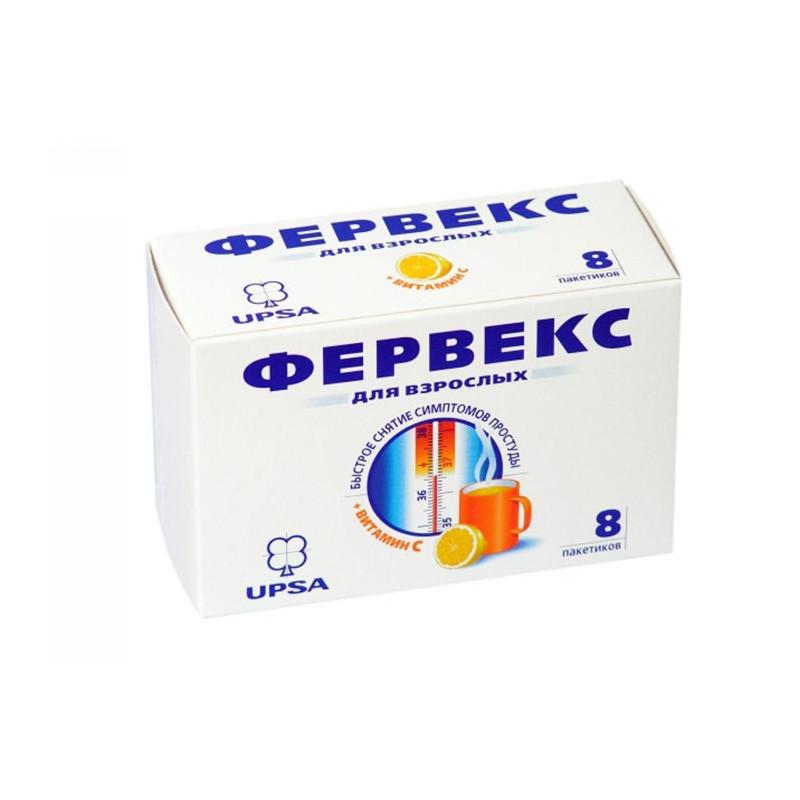



 All payments are encrypted via SSL
All payments are encrypted via SSL
 Full Refund if you haven't received your order
Full Refund if you haven't received your order
Powder for the preparation of oral solution
Paracetamol, Pheniramine Maleate, Ascorbic acid
Excipients: sucrose, anhydrous citric acid, gum arabic, soluble saccharin, lemon-rum flavoring (Antilles).
8 pieces
FERVEX - a combination drug for symptomatic treatment of acute respiratory infections.
Paracetamol is an antipyretic analgesic that has analgesic and antipyretic effects, due to its effect on the thermoregulation center in the hypothalamus; eliminates headache and other types of pain, reduces fever.
Ascorbic acid (vitamin C) is involved in the regulation of redox processes, carbohydrate metabolism, blood clotting, tissue regeneration, in the synthesis of GCS, collagen and procollagen; normalizes capillary permeability. Increases the body's resistance, which is associated with the stimulation of the immune system.
Pheniramine, a blocker of histamine H1 receptors, reduces rhinorrhea, nasal congestion, sneezing, tearing, itching and redness of the eyes.
- ARVI (symptomatic therapy);
- rhinopharyngitis.
- erosive and ulcerative lesions of the digestive tract (in the acute phase);
- renal failure;
- portal hypertension;
- chronic alcoholism;
- deficiency of glucose-6-phosphate dehydrogenase;
- children's age up to 15 years;
- I and III trimesters of pregnancy;
- lactation period (breastfeeding);
- hypersensitivity to the drug.
The drug should be used with caution in liver failure, angle-closure glaucoma, prostatic hyperplasia, congenital hyperbilirubinemia (Gilbert, Dubin-Johnson and Rotor syndromes), in viral hepatitis, alcoholic hepatitis, in elderly patients.
Fervex appoint inside on 1 bag 2-3 times / days. preferably between meals.The interval between doses of the drug is at least 4 hours.
In patients with impaired liver or kidney function and elderly patients, the interval between doses of the drug should be at least 8 hours.
The duration of treatment (without consulting a doctor) is no more than 5 days when used as an analgesic and no more than 3 days as a febrifuge.
The drug should be completely dissolved in a glass of warm water and immediately drink the resulting solution.
Gastrointestinal: nausea, epigastric pain; rarely, dry mouth; with prolonged use in doses significantly higher than recommended, increases the likelihood of abnormal liver function.
Hemic and lymphatic: rarely - anemia, thrombocytopenia, methemoglobinemia.
Urogenital: rarely, urinary retention; with prolonged use in doses significantly higher than recommended, increases the likelihood of impaired renal function.
Allergic reactions: skin rash, itching, urticaria, angioedema.
Other: rarely - accommodation paresis, drowsiness.
The drug is well tolerated in the recommended doses.
Antidepressants, anti-parkinsonian drugs, antipsychotics (phenothiazine derivatives) increase the risk of side effects (urinary retention, dry mouth, constipation) of Fervex.
With simultaneous use with Fervex GKS increase the risk of developing glaucoma.
Inductors of microsomal oxidation in the liver (phenytoin, ethanol, barbiturates, rifampicin, phenylbutazone, tricyclic antidepressants) increase the production of hydroxylated active metabolites of Paracetamol, which causes the possibility of severe intoxication with a small overdose of the drug.
Inhibitors of microsomal oxidation (including cimetidine) reduce the risk of hepatotoxic action of paracetamol.
Paracetamol reduces the effectiveness of uricosuric drugs.
Ethanol contributes to the development of acute pancreatitis.
Ethanol enhances the sedative effect of antihistamines.
Symptoms caused by the action of paracetamol: pallor of the skin, loss of appetite, nausea, vomiting; hepatonecrosis (severity of necrosis due to intoxication directly depends on the degree of overdose). Toxic effects in adults are possible after taking paracetamol at a dose of more than 10-15 g: an increase in liver transaminase activity, an increase in prothrombin time (12-48 hours after administration); A detailed clinical picture of liver damage occurs after 1-6 days. Rarely - fulminant development of liver failure, which may be complicated by renal failure (tubular necrosis).
Treatment: in the first 6 hours after an overdose - gastric lavage, the introduction of SH-group donators and the precursors of the synthesis of glutathione - methionine 8-9 hours after the overdose and N-acetylcysteine after 12 hours. The need for additional therapeutic measures (further introduction of methionine the introduction of N-acetylcysteine) is determined by the concentration of paracetamol in the blood, as well as the time elapsed after its intake.
The drug should be stored out of the reach of children, in a dry place at a temperature not exceeding 25 ° C.
Fervex ups